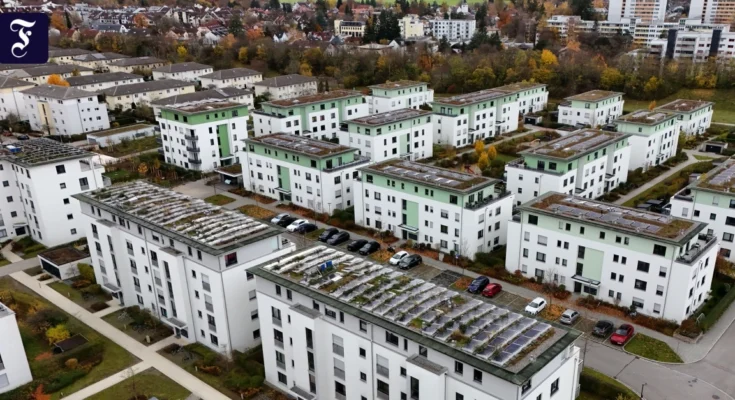After a phase of falling prices, house prices in Germany have risen sharply again. This can be seen from the figures from the German Bank Association Pfandbrief for the third quarter, published on Monday. It is considered relatively reliable in the real estate industry; Official figures from the Federal Statistical Office will only be presented in December. Real estate prices in July, August and September were on average 3.6 percent higher than a year earlier.
This development is primarily driven by residential real estate prices, as emphasized by Jens Tolckmitt, general manager of the association. This figure increased by an average of 3.8 percent. Prices of multi-family homes rose by 5.2 percent, single-family homes and condominiums by 2.4 percent.
Regarding commercial real estate, there are differences depending on the type of building. On average, prices of these products increased by 2.8 percent over the year, the association reported. Prices for offices, which previously experienced the impact of the home office trend, have now increased by 3.0 percent over the year. Retail property prices rose by 2.2 percent. “Transaction activity in the commercial real estate market continues to be concentrated in the upper segments,” Tolkmitt reported.
Frankfurt has become even more expensive
For residential properties, there are again significant differences depending on the city or county. In Germany’s seven largest cities – Berlin, Munich, Hamburg, Cologne, Düsseldorf, Frankfurt and Stuttgart – residential property prices rose by an average of 4.6 percent, more than the average for the entire region.
Prices in Frankfurt, where price declines had previously been particularly severe, rose by 4.9 percent. In Munich, where the price level was very high, prices rose by 5.3 percent, in Hamburg and Cologne by 5.2 percent, in Düsseldorf by 5.1 percent, in Berlin by 4.3 percent, and in Stuttgart by 2.4 percent.
“Real estate prices in Germany have been rising since spring 2024,” Tolkmitt said. “The recovery phase in the real estate market continues to strengthen.” Buyers and sellers in the real estate market seem to have accepted the new framework conditions such as interest rate developments.
Last week, the German Bundesbank also assessed in its 2025 Financial Stability Report that overvaluations and risks in relation to residential real estate have reduced, while the situation in the commercial real estate sector remains “fragile”.
In the spring and summer of 2023, at the height of discussions regarding heating laws in Germany, many owners of older single-family homes in rural areas expressed concerns that they might not be able to sell their homes at all or only at a steep discount. This is also due to the fact that it is still very unclear how political guidelines for energy-efficient real estate renovation will develop.
Based on data from its housing atlas, Postbank reported at the time that the price difference between properties that have been renovated in an exemplary manner and those that have not been renovated can reach, for example, 1,577 euros per square meter in Frankfurt, 1,727 euros in Munich, 1,431 euros in Hamburg and 1,116 euros in Berlin. That would be a lot.
His excitement had probably died down a bit by now. The energetic condition of a house is still an important criterion for determining the selling price, especially for office properties. Fears of possibly no longer being able to sell older single-family homes in the country because the old heating systems may be gone.
“There are bigger price discounts for buildings with high energy consumption, which are also fairly constant,” said Michael Voigtländer, a real estate expert at the German Economic Institute in Cologne. “However, the market has started to calm down and demand for older buildings is increasing – also due to better entry prices.” Therefore, the price gap between old and new houses will continue to narrow in the future.
“In pure economic terms, an apartment or house can only be worth much less because of an old heating system compared to the cost of installing a new, contemporary heating system – plus, if necessary, a small additional cost for effort and noise,” says Reiner Braun, chairman of the real estate institute Empirica in Berlin: “At the moment there is actually a higher discount due to uncertainty – but that is probably more due to short-term hysteria.”
Since home buyers typically undertake renovations, modernizations, extensions and conversions, installation should be less complicated for buyers than sellers, Braun said. In particular, installing a heat pump often makes more sense for the buyer than the seller because the buyer knows his or her future plans for the basement and other rooms in the home as well as the renovation work required.
In any case, Postbank is very confident about the further development of real estate prices in Germany from the perspective of its owners. The Pfandbrief Bank Association also pointed to the ongoing housing shortage. Since there are few new buildings currently, the price increases in the statistics are largely based on existing buildings.
In recent months, building interest rates have at least not risen as much as some building finance experts had predicted. According to figures from FMH Finanz Beratung in Frankfurt, those looking to build are currently paying an average of 3.66 per cent for loans with a ten-year interest rate fix. This number is slightly lower than in September. The increase in interest rates is not directly linked to the European Central Bank’s key interest rate, but rather to ten-year federal bond yields via the Pfandbrief yield. The figure rose in the spring along with the federal government’s plans to increase the national debt and spending and recently fluctuated at 2.7 percent. Construction finance experts, regularly surveyed by credit broker Interhyp, expect sideways developments in the next few weeks to the end of the year. By next year, interest rates could rise by as much as four percent, experts say. Rising interest rates tend to slow property prices – but this can also be overshadowed by other developments.
The highest increase is expected to occur in Leipzig
In the long term, real estate price developments in Germany will likely vary depending on the region, Postbank said. By 2035, existing condominium purchase prices are expected to increase on average across all districts and townships by 0.4 percent per year in real terms, i.e. adjusted for inflation.
The bank expects the highest price increases in Leipzig, which has developed very positively. He expects the biggest price drop to occur in the Dessau-Roßlau district of Saxony-Anhalt. Price increases are likely to be particularly large in some large and medium-sized cities, in areas around the seven largest metropolitan cities, in parts of southern Germany, and in some holiday areas. Postbank expects only slight increases in real prices for some regions in North Rhine-Westphalia and Rhineland-Pfalz, but also for some regions in Lower Saxony and northeastern Bavaria. Price reductions are expected in rural areas, especially in new federal states. Postbank also expects real estate prices to fall in the Goslar, Holzminden and Wunsiedel districts, the Märkischer Kreis and the Ennepe-Ruhr district, for example.



